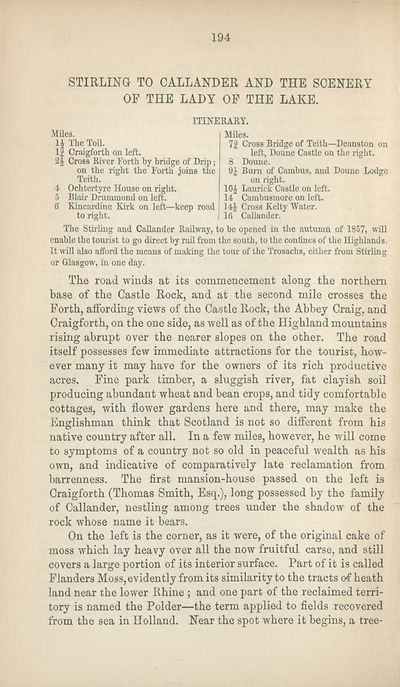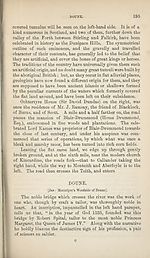Download files
Complete book:
Individual page:
Thumbnail gallery: Grid view | List view

194
STIRLING TO CALLANDER AND THE SCENERY
OF THE LADY OF THE LAKE.
ITINERARY.
Miles.
4 The Toll.
l| Craigforth on left.
2| Cross River Forth by bridge of Drip;
on the right the Forth joins the
Teith.
4 Ochtertyre House on right.
5 Blair Drummond on left.
6 Kincardine Kirk on left—keep road
Miles.
7| Cross Bridge of Teith—Deanston on
left, Doune Castle on the right.
8 Doune.
9J Burn of Cambus, and Doune Lodge
on right.
lOJ Lanrick Castle on left.
14 Cambusmore on left.
141 Cross Kelty Water.
16 Callander.
The Stirling and Callander Railway, to be opened in the autumn of 1857, will
enable the tourist to go direct by rail from the south, to the confines of the Highlands.
It will also afford the means of making the tour of the Trosachs, either from Stirling
or Glasgow, in one day.
The road winds at its commencement along the northern
base of the Castle Rock, and at the second mile crosses the
Forth, affording views of the Castle Rock, the Abbey Craig, and
Craigforth, on the one side, as well as of the Highland mountains
rising abrupt over the nearer slopes on the other. The road
itself possesses few immediate attractions for the tourist, how¬
ever many it may have for the owners of its rich productive
acres. Fine park timber, a sluggish river, fat clayish soil
producing abundant wheat and bean crops, and tidy comfortable
cottages, with flower gardens here and there, may make the
Englishman think that Scotland is not so different from his
native country after all. In a few miles, however, he will come
to symptoms of a country not so old in peaceful wealth as his
own, and indicative of comparatively late reclamation from
barrenness. The first mansion-house passed on the left is
Craigforth (Thomas Smith, Esq.), long possessed by the family
of Callander, nestling among trees under the shadow of the
rock whose name it bears.
On the left is the corner, as it were, of the original cake of
moss which lay heavy over all the now fruitful carse, and still
covers a large portion of its interior surface. Part of it is called
Flanders Moss, evidently from its similarity to the tracts of heath
land near the lower Rhine ; and one part of the reclaimed terri¬
tory is named the Polder—the term applied to fields recovered
from the sea in Holland. Near the spot where it begins, a tree-
STIRLING TO CALLANDER AND THE SCENERY
OF THE LADY OF THE LAKE.
ITINERARY.
Miles.
4 The Toll.
l| Craigforth on left.
2| Cross River Forth by bridge of Drip;
on the right the Forth joins the
Teith.
4 Ochtertyre House on right.
5 Blair Drummond on left.
6 Kincardine Kirk on left—keep road
Miles.
7| Cross Bridge of Teith—Deanston on
left, Doune Castle on the right.
8 Doune.
9J Burn of Cambus, and Doune Lodge
on right.
lOJ Lanrick Castle on left.
14 Cambusmore on left.
141 Cross Kelty Water.
16 Callander.
The Stirling and Callander Railway, to be opened in the autumn of 1857, will
enable the tourist to go direct by rail from the south, to the confines of the Highlands.
It will also afford the means of making the tour of the Trosachs, either from Stirling
or Glasgow, in one day.
The road winds at its commencement along the northern
base of the Castle Rock, and at the second mile crosses the
Forth, affording views of the Castle Rock, the Abbey Craig, and
Craigforth, on the one side, as well as of the Highland mountains
rising abrupt over the nearer slopes on the other. The road
itself possesses few immediate attractions for the tourist, how¬
ever many it may have for the owners of its rich productive
acres. Fine park timber, a sluggish river, fat clayish soil
producing abundant wheat and bean crops, and tidy comfortable
cottages, with flower gardens here and there, may make the
Englishman think that Scotland is not so different from his
native country after all. In a few miles, however, he will come
to symptoms of a country not so old in peaceful wealth as his
own, and indicative of comparatively late reclamation from
barrenness. The first mansion-house passed on the left is
Craigforth (Thomas Smith, Esq.), long possessed by the family
of Callander, nestling among trees under the shadow of the
rock whose name it bears.
On the left is the corner, as it were, of the original cake of
moss which lay heavy over all the now fruitful carse, and still
covers a large portion of its interior surface. Part of it is called
Flanders Moss, evidently from its similarity to the tracts of heath
land near the lower Rhine ; and one part of the reclaimed terri¬
tory is named the Polder—the term applied to fields recovered
from the sea in Holland. Near the spot where it begins, a tree-
Set display mode to:
![]() Universal Viewer |
Universal Viewer | ![]() Mirador |
Large image | Transcription
Mirador |
Large image | Transcription
| Antiquarian books of Scotland > Scotland/Scots > Black's picturesque tourist of Scotland > (274) |
|---|
| Permanent URL | https://digital.nls.uk/130031478 |
|---|
| Description | Thousands of printed books from the Antiquarian Books of Scotland collection which dates from 1641 to the 1980s. The collection consists of 14,800 books which were published in Scotland or have a Scottish connection, e.g. through the author, printer or owner. Subjects covered include sport, education, diseases, adventure, occupations, Jacobites, politics and religion. Among the 29 languages represented are English, Gaelic, Italian, French, Russian and Swedish. |
|---|

